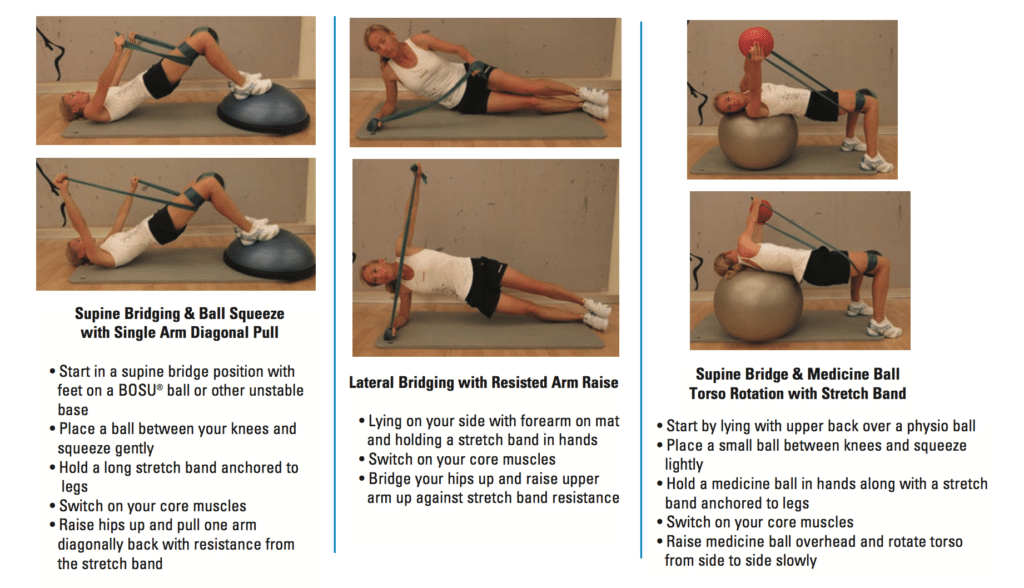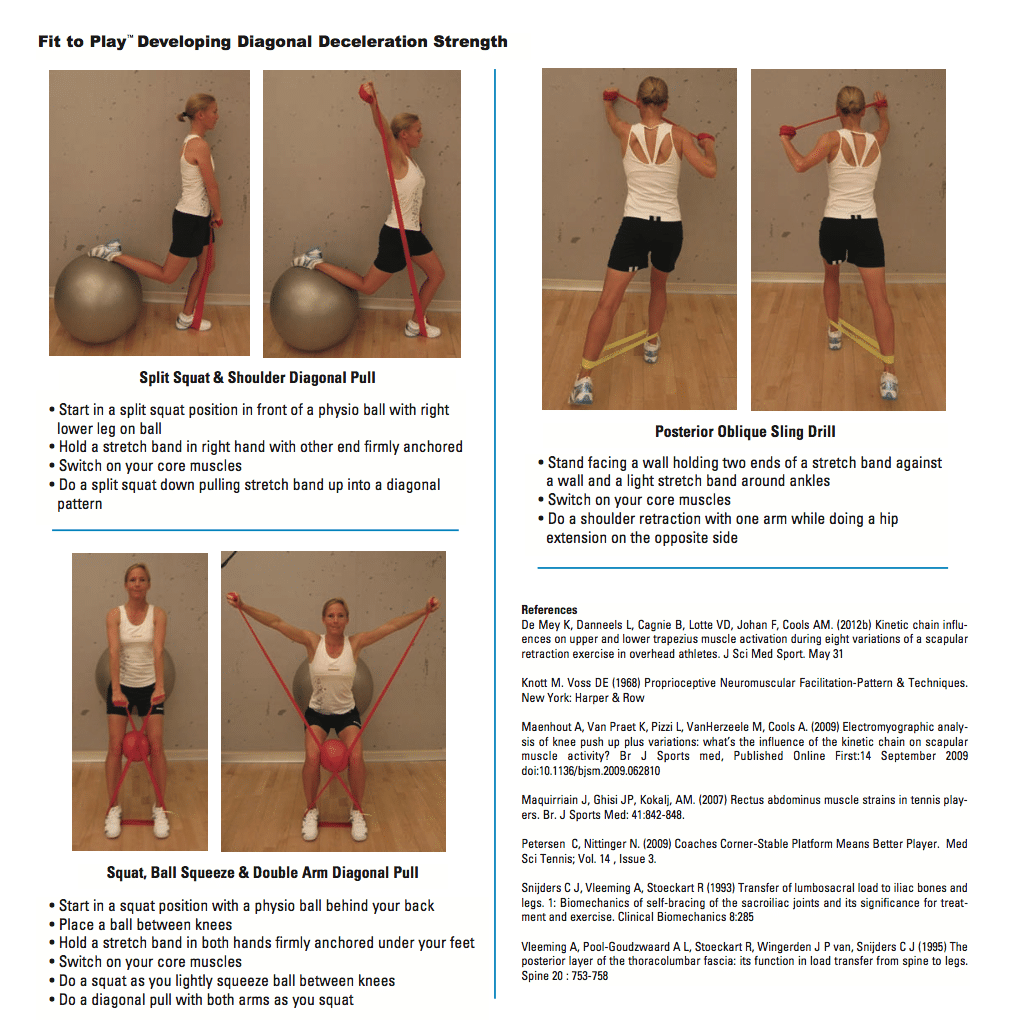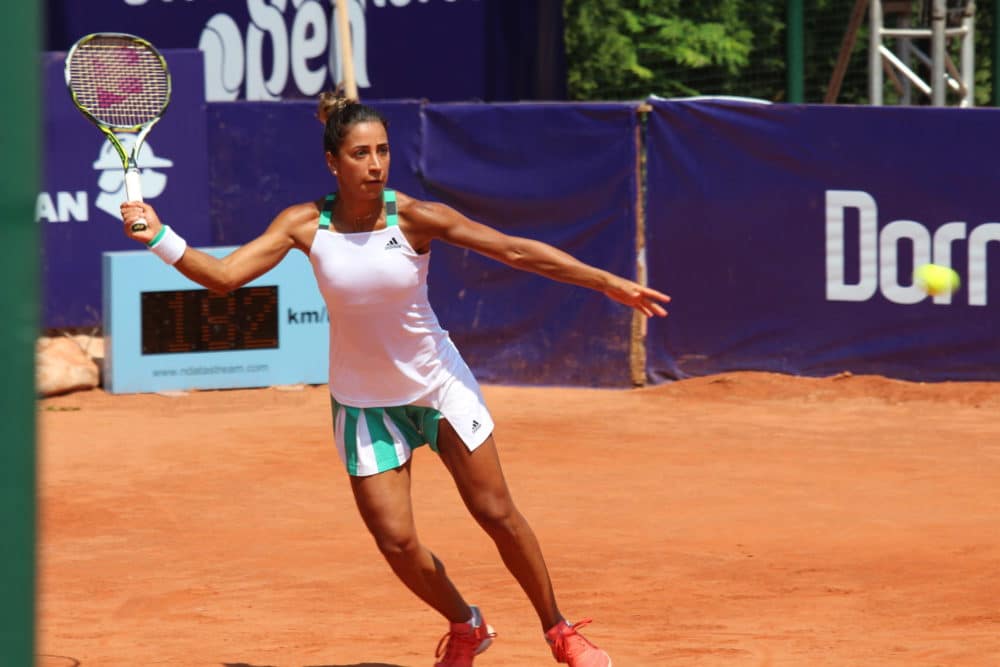Tennis is an explosive sport, requiring players to react to emergencies with multidirectional movement through multiple planes for short bursts of time. Movements in tennis include lateral and linear motion, twisting, sliding and dynamic acceleration and deceleration of the kinetic chain in diagonal patterns. These quick torsional movements pass through many planes of motion and create rotational and spiral forces on numerous joints and muscles at the same time.
In tennis players, the abdominal musculature plays a significant role in trunk and core stability, providing a mechanical link between the lower and upper limbs (Maquirrian et al, 2007). Four slings of muscle systems: the anterior oblique, posterior oblique, lateral and longitudinal, have been well described in the literature (Vleeming et al, 1995) (Snijders et al, 1993). These slings of muscles help transfer energy from the legs through the core (trunk) to the upper body and arms, which are important in all strokes, especially the serve. Through a kinetic chain of sequential acti- vation of body segments from the ground to the hand, mathematical analysis of the contributions of different segments of the body to the ener- gy and force, has shown 51% of the energy and 54% of the force is gen- erated by the legs and trunk muscles (Kibler et al, 2010).
Utilizing closed and partially closed chain exercises with varied band resistance to increase stability of the four different slings will help improve the athlete’s ability to accelerate and decelerate the swinging motion within these diagonal patterns and improve connected core sta- bility. If connected core (upper and lower) stability is inadequate, this can lead to alterations in length tension relationships of muscle and fascial tissue and potential for malalignment issues. This malalignment can be exacerbated by the unilateral (one sided) nature of tennis strokes, since in the modern game, 75% of the strokes are forehand or service motion placing abnormal rotational and deceleration stresses on the dominant side (Petersen & Nittinger, 2009).
Tennis strokes require explosive acceleration and dynamic diagonal deceleration control to protect the kinetic chain against overuse and acute injury. Certain regions of musculature are often weak as a result of training and playing overuse that results in fatigue, active trigger points and palpable tissue tension. We regularly see players who develop injuries to the upper and lower extremities related to these diagonal deceleration movement patterns and must take steps to strengthen them.
Many commonly prescribed exercises are machine based and involve or isolate a single joint and only allow movement in one plane of motion. Normally individuals do not move as well in straight paths, but are better suited to rotational motion, torque and angular movement with full kinetic chain involvement. Past literature has shown the importance of proprio- ceptive neromuscular facilitation – patterns and techniques using spring systems (Knott & Voss, 1968). As well, more recent research has demon- strated that lower extremity position influences scapular muscle recruit- ment and muscle balance ratios in closed kinetic chain exercises (Maen- hout et al, 2009). These same earlier described diagonal patterns and recent research on muscle recruitment can be used to help augment the four myofascial sling components to develop diagonal deceleration strength.
The following is a series of innovative functional connected core stability exercises taken from our new My Pocket Coach Fitness 1 www.my-pock- et-coach.com that help develop dynamic diagonal deceleration. These practical exercises use a variety of equipment commonly found in the training and rehab environment. Start with 1-2 sets of 5-10 repetitions and increase to 2-3 sets of 10-15 repetitions.


by Carl Petersen BPE, BSc(PT) & Nina Nittinger Dipl. KFFR/Sports Mgt.
Carl is a physiotherapist and the Director of High Performance at City Sports & Physiotherapy Clinic www.citysportsphysio.com
Nina is a former professional player who now coaches full time in Davos, Switzerland. Visit her website at www.ninisports.com
Their book Fit to PlayTM- Tennis and Fit to PlayTM & Perform DVDs can be found at the PTR shop.
Their new My Pocket Coach Fitness 1 can be found at www.my-pocket-coach.com

